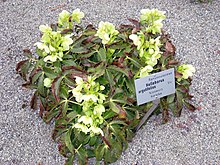Botanical Garden of the University of Innsbruck
The Botanical Garden of the University of Innsbruck was founded in 1793 and has been at its current location in the Hötting district since 1913 . It is home to over 7000 species of plants on an area of 2 hectares. It is the teaching and research facility of the Institute for Botany at the Leopold-Franzens University Innsbruck and is freely accessible to the public.
history
Since 1775, Suibert Burkhart Schiverek , professor of botany and chemistry at the medical faculty, tried to establish a botanical garden, which was prevented by the abolition of the university by Emperor Joseph II in 1782 and the transfer of Schiverek to Lemberg . In 1792, one year after the university was rebuilt, Johann Nepomuk von Laicharting was appointed professor of natural history. Together with the court pharmacist Franz Xaver Schöpfer, he again campaigned for the establishment of a botanical garden, which was finally founded in 1793 on the site of the abolished Jesuit college (today's theological faculty).
During the renewed dissolution of the university from 1809 to 1826, the botanical garden was badly affected and only experienced an upswing from 1860 under Anton Kerner von Marilaun . At that time the first glass house was built, which also housed numerous tropical plants. The model for other botanical gardens was the world's first alpine plant complex with over 800 plant species.
Since the botanical garden at the old university in the city center could not be expanded, it was moved from 1909 to 1910 to its current location in Hötting, which was still independent at the time, on the slope of the Nordkette . The land was acquired by the astronomy professor Egon von Oppolzer , who had set up a private observatory there. In 1911 the gardens were largely completed, and in October 1913 the new Botanical Institute was opened. Emil Heinricher , garden director from 1889 to 1928, designed the garden according to biological groups, which was exemplary for other botanical gardens.
In 1929 the construction of the alpine garden on the Patscherkofel began, which was opened in 1935 and presents the naturally occurring plant communities of the high mountains.
Areas
A large part of the botanical garden is taken up by the park with the arboretum , which mainly shows trees and shrubs from the temperate climatic zones of the northern hemisphere. In the western part there are gymnosperms and conifers , in the central part angiosperms such as magnolia , tulip tree or Araliaceae .
The fragrance and touch garden in the central area of the arboretum was opened in 1999 and offers visually impaired visitors in particular the opportunity to experience plants with their sense of smell and touch. Along a wheelchair-friendly circular path there are 85 cm high beds with selected plants, the signs are also in Braille .
The Alpinum is home to plants from all major mountains on earth with the exception of the tropics on an area of more than 2000 m². It is structured geographically and geologically and includes four ponds connected by streams.
The systematic show garden shows numerous individual plants in a systematic manner. It was re-created in 1993 and repeatedly adapted to the current state of research.
On the northern edge of the Botanical Garden are the greenhouses, including the cactus house with around 650 species of cacti , the succulent house with succulents mainly from South Africa, South America and the Canary Islands, the fern house , the tropical house and the Mediterranean house . The alpine house , completed in 2002, is used for the cultivation of delicate and rare mountain plants from all over the world, which cannot easily adapt to the lowland climate . The foundation of the Alpinhaus lies around 1 m below the surface of the earth, which means less cooling in winter and slower warming in summer.
literature
- Eva Berger: Historic Gardens of Austria: Gardens and parks from the Renaissance to around 1930. Volume 2: Upper Austria, Salzburg, Vorarlberg, Carinthia, Styria, Tyrol . Böhlau, Vienna 2003, ISBN 3-205-99352-7 , p. 639-640 .
- Georg Gärtner: On the past and future of the Botanical Garden of the University of Innsbruck. In: Reports of the Natural Science and Medical Association in Innsbruck, Volume 69, 1982, pp. 19–27 ( PDF; 4.2 MB )
- Georg Gärtner: The fragrance and touch garden for the visually impaired and the blind in the Botanical Garden of the University of Innsbruck. In: Wulfenia, Mitteilungen des Kärntner Botanikzentrum Klagenfurt, No. 7, 2000, pp. 107–113 ( PDF; 1.7 MB )
Web links
- Botanical Garden of the University of Innsbruck
- Innsbruck Botanical Garden , Botanic Gardens Conservation International
Coordinates: 47 ° 16 ′ 4 ″ N , 11 ° 22 ′ 46 ″ E





